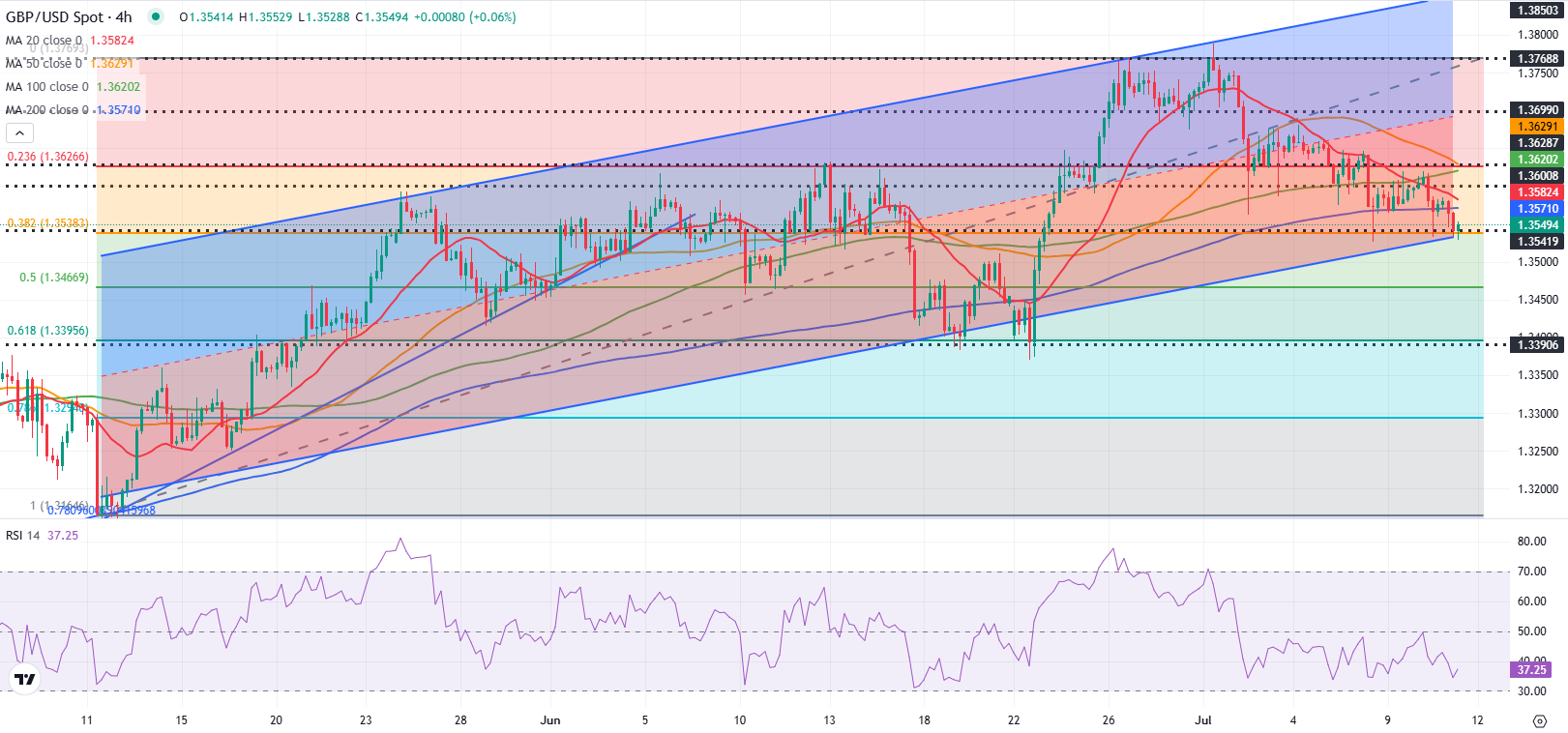- GBP/USD trades in negative territory below 1.3550 on Friday.
- The US Dollar could preserve its strength unless risk flows return to markets.
- The technical outlook suggests that sellers look to retain control in the near term.
After closing marginally lower on Thursday, GBP/USD stays on the back foot and trades below 1.3550 in the European session on Friday. The negative shift seen in risk mood could make it difficult for the pair to stage a rebound heading into the weekend.
British Pound PRICE This week
The table below shows the percentage change of British Pound (GBP) against listed major currencies this week. British Pound was the weakest against the Australian Dollar.
| USD | EUR | GBP | JPY | CAD | AUD | NZD | CHF | |
|---|---|---|---|---|---|---|---|---|
| USD | 0.76% | 0.83% | 1.94% | 0.73% | -0.38% | 0.65% | 0.35% | |
| EUR | -0.76% | 0.08% | 0.95% | -0.06% | -1.07% | -0.12% | -0.44% | |
| GBP | -0.83% | -0.08% | 0.86% | -0.11% | -1.15% | -0.19% | -0.64% | |
| JPY | -1.94% | -0.95% | -0.86% | -0.97% | -2.07% | -1.05% | -1.52% | |
| CAD | -0.73% | 0.06% | 0.11% | 0.97% | -1.08% | -0.08% | -0.53% | |
| AUD | 0.38% | 1.07% | 1.15% | 2.07% | 1.08% | 1.06% | 0.50% | |
| NZD | -0.65% | 0.12% | 0.19% | 1.05% | 0.08% | -1.06% | -0.45% | |
| CHF | -0.35% | 0.44% | 0.64% | 1.52% | 0.53% | -0.50% | 0.45% |
The heat map shows percentage changes of major currencies against each other. The base currency is picked from the left column, while the quote currency is picked from the top row. For example, if you pick the British Pound from the left column and move along the horizontal line to the US Dollar, the percentage change displayed in the box will represent GBP (base)/USD (quote).
The US Dollar (USD) benefited from the better-than-forecast weekly Initial Jobless Claims data in the early American session on Thursday. Later in the day, US President Donald Trump’s tariff announcements caused markets to adopt a cautious stance, providing an additional boost to the USD and weighing on GBP/USD.
Trump said that they will impose 35% tariffs on Canadian imports from August 1 and added that they are planning to impose blanket levies of 15% or 20% on most trade partners. US stock index futures were last seen losing about 0.7% on the day. In case safe-haven flows dominate the action in financial markets, GBP/USD could find it hard to shake off the bearish pressure.
Meanwhile, the disappointing growth data from the UK seems to be hurting Pound Sterling on Friday. The UK’s Office for National Statistics announced that the Gross Domestic Product (GDP) contracted by 0.1% on a monthly basis in May. This reading followed the 0.3% contraction recorded in April and came in worse than the market expectation for an expansion of 0.1%.
GBP/USD Technical Analysis

GBP/USD trades near 1.3540, where the Fibonacci 23.6% retracement level of the latest uptrend and the lower limit of the ascending channel align. In case the pair falls below this level and starts using it as resistance, 1.3500 (50-day Simple Moving Average) could be seen as the next support level before 1.3465 (Fibonacci 50% retracement).
Looking north, resistance levels could be seen at 1.3570 (200-period Simple Moving Average), 1.3620 (Fibonacci 23.6% retracement) and 1.3700 (mid-point of the ascending channel).
Pound Sterling FAQs
The Pound Sterling (GBP) is the oldest currency in the world (886 AD) and the official currency of the United Kingdom. It is the fourth most traded unit for foreign exchange (FX) in the world, accounting for 12% of all transactions, averaging $630 billion a day, according to 2022 data.
Its key trading pairs are GBP/USD, also known as ‘Cable’, which accounts for 11% of FX, GBP/JPY, or the ‘Dragon’ as it is known by traders (3%), and EUR/GBP (2%). The Pound Sterling is issued by the Bank of England (BoE).
The single most important factor influencing the value of the Pound Sterling is monetary policy decided by the Bank of England. The BoE bases its decisions on whether it has achieved its primary goal of “price stability” – a steady inflation rate of around 2%. Its primary tool for achieving this is the adjustment of interest rates.
When inflation is too high, the BoE will try to rein it in by raising interest rates, making it more expensive for people and businesses to access credit. This is generally positive for GBP, as higher interest rates make the UK a more attractive place for global investors to park their money.
When inflation falls too low it is a sign economic growth is slowing. In this scenario, the BoE will consider lowering interest rates to cheapen credit so businesses will borrow more to invest in growth-generating projects.
Data releases gauge the health of the economy and can impact the value of the Pound Sterling. Indicators such as GDP, Manufacturing and Services PMIs, and employment can all influence the direction of the GBP.
A strong economy is good for Sterling. Not only does it attract more foreign investment but it may encourage the BoE to put up interest rates, which will directly strengthen GBP. Otherwise, if economic data is weak, the Pound Sterling is likely to fall.
Another significant data release for the Pound Sterling is the Trade Balance. This indicator measures the difference between what a country earns from its exports and what it spends on imports over a given period.
If a country produces highly sought-after exports, its currency will benefit purely from the extra demand created from foreign buyers seeking to purchase these goods. Therefore, a positive net Trade Balance strengthens a currency and vice versa for a negative balance.

